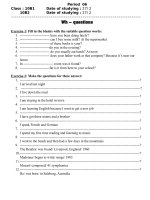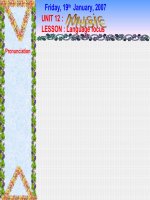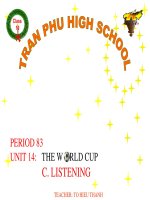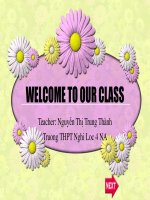unit 10-11-12 lop 10
Bạn đang xem bản rút gọn của tài liệu. Xem và tải ngay bản đầy đủ của tài liệu tại đây (181.3 KB, 34 trang )
Class 10a3 Date Absent
Class 10a4
Class 10a5
Class10a6
Class 10a7
The 59
th
period
Unit 10: Conservation
Lesson1. Reading
I. Objectives:
1. Aims: By the end of the lesson .Students will be able to:
- understand that forest and the earth give us a lot of valuable
things
- get information about destroying the earth, forest and animal
2. Knowledge:
- New words: words related to forest and animal
- Grammar. The passive voice
3. Skill:
Main -skill. Reading
Sub- skill.writing . speaking . listening
II.Teaching Method: Intergrated, mainly communicative
III. Teaching aids:Teacher. Textbook, hand-outs
Student. Textbook. notebook
IV. Procedures:
Teacher’s activities Students’ activities
Warm-up: (3 minutes)
- Ask students some questions
1. What is the meaning of the word
“conservation”?
2. Why do you have to protect forests
and animals?
3. How do you protect your earth?
- Ask students to work in pairs and give
their answers
- Give comments
A.Pre-reading: (5 minutes)
- Ask students some questions:
1. Have you ever visited a zoo or a
forest?
2. What animals are you interested in?
3. Do we need to protect animals and
forests?
- Say: “Ok, we have to protect animals
and forests because forests give us many
valuable things. Today, we study Unit 10
to know how important are forests and
animals in our lives”
- Answer the questions in pairs:
1. Consevation is the protection of
natural things such as plants and
animals.
2. Because forests give us a lot of
valuable things.
3. We shouldn’t pollute the air,
cut plants…
- Answer the questions
1. Yes, I have.
2. I’m interested in tiger
3. Yes, we do.
Listen to the teacher
1
B.While-reading: (26 minutes)
Task 1
- Ask students to read all words in A and
definition in B then read the passage to
find the words which appear in the
passage
- Ask students to match the words with a
suitable definition in B
- Let students work in pairs
- Walk round the class and give
comments when students need help
- Call on some students to explain their
answers in front of the class
-correct answers
Task 2
- Ask students to read the statements
carefully before doing the task
- Ask students to scan the passage to get
specific information and encourage
them to guess whether those statements
are T or F
- Let students work in pairs
- Go around the class and provide help
when necessary
- Check the answer in front of the class
Task 3
- Ask students to read all main ideas in
task 3
- Ask students to read the passage again
and choose the most suitable main idea
for each paragraph
- Ask students to work in groups
- Go around and provide help if needed
- Call on some students to give their
answers
- Give correct answers
Paragraph A:
Main idea: Forests give us a lot of
valuable things
Paragraph B:
Main idea: We can not live without
water
Paragraph C:
Main idea: Lets do something to save
- Read the passage and do task 1
- Work in pairs
- Listen to their friends’ answers
- Copy down the teacher’s
correction
- Give correct answers
1.c – 2.a – 3.d – 4.b
- Read the statements
- Work individually
- Work in pairs
- Give correct answers:
1.F-2.I-3.T-4.T-5.F-6.T
- Correct the answers
- Read the main ideas
- Read the passage again
- Work in groups
- Correct answers
Lisen to the teacher
2
the earth
Homework: (1 minutes)
- Ask students to discuss the question:
What should we do for the future of“
planet?”
Comment.
- listen to the teacher
Class 10a3 Date Absent
Class 10a4
Class 10a5
Class10a6
Class 10a7
The 60 th
period
Unit 10. Conservation
Lesson 2. Speaking
I. Objectives:
1. Aim: By the end of the lesson, students will be able to talk about plans to
protect animals
2. Knowledge:
- New words: Words related to animals
- Grammar. The passive voice
3. Skill:
Main skill.Speaking
Sub skill.Reading. listening. writing
II.Teaching Method: Intergrated, mainly communicative
III. Teaching aids:Teacher. textbook, hand-outs
Student. Textbook. notebook
IV. Procedures:
Teacher’s activities Students’ activities
A. Pre-speaking: (9 minutes)
- Give hand-outs and explain how to
do: below is a list of animals.
Classifiy them to the following
- Listen to the teacher
3
catergories
Farm
animals
Wild and zoo
animals
Pets
horse, elephant, monkey, sheep, pig,
tiger, lion, cat, fish, panda, tortoise
- Ask students to work in pairs
- Check the answers in front of the
class
What animals are in danger?
- Say: “Ok, nowadays, many kinds of
valuable animals are in danger. Such
as: elephant, tiger… so how people
do to protect them. Now, we will
come to part B: Speaking and find
how people protect them”
B.While-speaking: (25 minutes)
Task 1
- Ask students to read the paragraph
first
- Ask students to work in pairs
- Go around the class and check
- Call on some students to read their
answers
- Give correct answers
- Work in pairs and do the task
- Copy down
1. The loss of much forest is
destroying the earth.
2. Man and most animals need a
constant supply of water to live.
Farmers need water for the crops
3. We should stop polluting rivers and
seas and stop the disappearance of
plants and animals
- Answer the question
They are elephant, tiger, lion, tortoise
ect.
- Listen to the teacher
- Read the passage
- Work in pairs
- Correct answers
Keys.
1. It is used to provide as natural an
environment as possible for the
animals.
2. The places where endangered
4
- Ask some students to translate into
Vietnamese
- Give comments
Task 2
- Ask students to read all statements
then put a tick in the right box to
show their agreement or
disagreement
- Let students wok in pairs
- Go round the class and provide help
when needed
- Check the answer in front of the
class
- correct answers:
Task 3
- Ask students to read all statements
- Ask students to work in pairs
- Go around the class and provide
help if necessary
- Call on some students to discuss the
advantages and disadvantages of zoos
of the new kind
- Encourage students to make some
dialogues
- Give comments and suggestions
Advantages:
+ the conditions the animals are in
+ the animals that people can visit
Disadvantages:
+ the money spent on rescontructions
of the animals natural environment
+ the dangers that the keeper may
have
- Go around and provide help when
needed
- Give comments
Homework: (1 minutes)
- Ask students to write a short
paragraph about the animals’ natural
zoo
species can develop. Animals can live
in natural environment. They are not
the places where animals are
imprisoned
Listen to the teacher
- Read all the statements
- Work in pairs
Copy down the answers
- Give correct answers:
1. Yes- 2.No- 3.Yes- 4.Yes- 5.Yes
- Read all the statements
- Work in pairs
- Do discussing
- Listen to the teacher and writedown
Class 10a3 Date Absent
Class 10a4
Class 10a5
Class10a6
Class 10a7
5
The 61
ts
period
UNIT 10. Conservation
Lesson 3. listening
Time: 45 minutes
I. Objectives:
1. aim: By the end of the lesson, students can be able to Students can listen
and understand some information about a forest fire
2. Knowledge:
- Language: Words related to whales
- Grammar. The passive voice
3. Skill:
Main skill.Listening
Sub skill. Reading. Speaking. writing
II. Teaching Method: Intergrated, mainly communicative
III. Teaching aids: Teacher .textbook, board .tape & castes
Student. Notebook. textbook
IV. Procedures:
Teacher’s activities Students’ activities
A.Pre-listening:
- Raise the question:
What may cause a forest fire?
- Ask students to work in pairs
- Call some students to read their
answers
- Give comments
- Give suggested answer: Some
reasons may cause a forest fire
+ A campfire near a heap of leaves
may easily cause a forest fire
+ In late summer, forest may easily
catch fire
- Ask students to close their books
- Ask students to listen all the words
related to the paragraph and repeat
B.While-listening:
Task 1
- Ask students to read all events
carefully before listening
- Encourage students to guess
- Ask students to do the task
individually first
- Play the tape and ask them to number
the events in the order they hear
- Has students compare their answers
with their friends
- Call on some students to give their
answers
- Listen to the teacher and answer the
question
- Work in pairs
- Listen to the teacher
- Close the books and listen to the tape
- Read carefully
- Work individually
- Listen to the tape and number the
events
- Work in pairs
- Listen to their friends’ answers
- Correct answers
6
- correct answers:
Task 2: True or False
- Ask students to guess if the statements
are T or F before listening
- Ask students to listen and decide
whether those statements are T or F
- Ask students to work individually
- Call on some students to read their
answers
- Give comments and give correct
answers:
Task 3
- Ask students to read all sentences
- Ask students to work individually
- Ask students to listen and tick the
sentences they hear
- Has students compare their
answers with their friends
- Call on some students to read their
answers
- Give comments and correct
answers:
D.Homework:
- Ask students to write a short
paragraph about “What may cause a
forest fire?”
Comment
3, 2, 5, 1, 4
- Try to guess
- Listen carefully
- Work individually
- Correct mistakes
- correct answers:
1.F - 2.F - 3.T - 4.T - 5.F
- Read all sentences
- Work individually
- Compare their answer with their
friends
- Copy down
answers:
1.B 2.A 3.A– –
- Listen to their friends’ topics
- Listen to the teacher and write down
7
Class 10a3 Date Absent
Class 10a4
Class 10a5
Class10a6
Class 10a7
The 62nd
period
Unit 10. Conservation
Lesson 4.Writing
I. Objectives:
1. Aims: By the end of the lesson, students will be able to write a letter of
invitation
2. Knowledge:
- New words: Words related to invitaion verb-phrases
- Grammar. The passive voice
3. Skill:
Main skill. Writing
Sub skill. Listening. Speaking. Reading.
II. Teaching Method: Intergrated, mainly communicative
III. Teaching aids:Teacher. Textbook
Notebook. textbook
IV. Procedures:
Teacher’s activities Students’ activities
8
A. Pre-writing:
- Ask students some questions:
1. Have you written a letter of
invitation?
2. What are some expression do you
write in a letter of invitation?
- Ask students to work in pairs
- Call on some students to read their
answers
- Give suggested answers
* Would you like to go out this
evening?
* Why don’t you go to the cinema with
me?
* Let’s go to the cinema.
- Say: “There are many expressions
those you can use to write a letter of
invitation. Today, we study part D.
Writing to study how to write a letter
of invitation”
B.While-writing:
Task 1
- Tell students to read all sentences
quickly
- Explain some new structures:
+ How about + V-ing
+ Do you feel like + V-ing
+ Would you like + to infinitive
+ Are you free + to infinitive
+ Why don’t you + bare infinitive
+ Shall we + bare infinitive
+ Can you + bare infinitive
- Ask students to write out the sentences
by matching the first half in A with the
most suitable half in B
- Ask students to work in pairs
- Go around to provide help if
necessary
- Call on some students to read their
answers
- Correct and give suggested answers:
Task 2
- Ask students to read task 2
- Ask students to fill each blank in
these invitation letters with a suitable
expression
- Answer the questions
- Work in pairs
- Copy the answers
- Listen to the teacher
- Read quickly
- Copy down
- Do matching
- Work in pairs
- Correct answers
suggested answers:
1.e – 2.g – 3.a – 4.h – 5.i – 6.d –
7.e – 8.b
- Read the task
9
- Let students work in pairs
- Go around to provide help
- Ask students to give their answers
- Correct and give suggested answers
1. would you like
2. Are you free/ do you like
3. Can you/ let’s
D. Homework:
- Ask students to rewrite a letter
- Work in pairs
- Listen to their friends’ answers
- Correct the answers
- Listen to the teacher and write
down
Class 10a3 Date Absent
Class 10a4
Class 10a5
Class10a6
Class 10a7
The 63
rd
period
10
Unit 10: Conservation
Lesson 5.Language focus
I. Objectives:
1. Aim: By the end of this lesson, students will be able to:
Students can pronounce 2 sounds /b/ and /p/ correctly and understand how to
use the passive voice
2. Knowledge:
- New words: words related to sounds /p/ - /b/ and the passive voice
- Grammar. The passive voice
3. Skill:
Main skill: 4 skill
II. Teaching Method: Intergrated, mainly communicative
III. Teaching aids: Textbook, tape, cassette player, handout
Student. Textbook. notebook
IV. Procedures:
Teacher’s activities Students’ activities
A. Pronunciation:
+ Listen and repeat
- Demonstrate the sounds /p/ - /b/ by
pronouncing them clearly and slowly
- Write on the board some words
related to 2 sounds /p/ and /b/
/b/: bee, ban, bad, bright
/p/: pea, pan, power
- Ask students to read loudly
- Call some students to repeat the
sounds clearly
- Check and correct their
pronunciation
+ Practise these sentences
- Ask students to work in pairs and
practice the sentences
- Go around and help students
- Call on some students to read the
sentences loudly
B. Grammar:
The passive voice
Be + P2
a. Simple present passive:
- Give examples:
I am not invited to parties very often.
The floor is cleaned by my mother.
- Ask students to read all sentences
- Ask students to give form of simple
present passive
- Give correct form:
- Listen to the teacher
- Copy down
- Read in chorus
- Listen and repeat
- Work in pairs
- Practise the sentences
- Listen to the teacher and write down
- Read all the sentences in chorus
- Give the form
11
S + am/is/are + P2
- Ask students to make sentences
b. Present progressive passive:
- Give some examples
Many new roads are being built in
this city.
The earth is being threatened.
- Ask students to read all sentences
- Ask students to give form of present
progressive passive
- Give comments
- Give correct form:
S + am/is/are + being + P2
- Ask students to give some examples
Exercise 1
- Ask students to do exercise 1
- Has students compare their answers
with a friend
- Check the answers in front of the
class
- Give suggested answers:
1. were reported
2. grown
3. be spoken
4. am not invited
5. are being built
Exercise 2
- Ask students to do exercise 2
- Go around and give help if
necessary
- Call one student to do exercise 2
- Check the answers in front of the
class
- Give correct answers:
1. came/ had started/ were
2. is standing/ is photographed
3. have/ told
4. was laid/ decided
5. are… planted
Exercise 3
- Ask students to do exercise 3
- Go around and help students
- Call on one some students to give
answers
- Correct mistakes
- Give correct answers:
- Listen to the teacher and take notes
- Read in chorus
- Give form
- Copy down
- Do the task
- Work in pairs
- Give answers
- Correct the answers
- Do individually
- Look at the board and find out
mistakes
- Correct answers
- Work in pairs
- Find out mistakes
- Correct mistakes
- Copy down
1. was organized
2. arrived
12
C.Homework:
- Ask students to do exercise in
workbook
- Ask students to prepare Unit 11 at
home
3. were met
4. taken
5. were cleaned/ had been cleaned
6. were put/ had been put
7. was
8. prepared
9. made
10. were sewed
- Listen to the teacher and write in
the notebooks
Class 10a3 Date Absent
Class 10a4
Class 10a5
Class10a6
Class 10a7
The 64
th
period
Unit 11: National parks
Lesson 1: Reading
I. Objectives:
1. Aims: By the end of the lesson, students can know information of some
national parks
2. Knowledge:
- Language: Students read and talk about forests
- New words: words related to forests: trees, animals, mountains…
3. Skill:
Main- skill.Reading
Sub- skills
II. Method: Intergrated, mainly communicative
III. Teaching aids: Teacher.Textbook, some photos of forests or national parks
Student. Textbook. notebook
IV. Procedures:
Teacher’s activities Students’ activities
Warm-up:
- Give the picture of forest and ask some
questions:
* What can you see in the picture?
* What can forests provide us with?
* Can they help us protect the
environment?
- Observe the picture
- We can see trees, animals,
mountains…
- They provide us with tree, food,
animals, some products of trees…
13
A.Pre-reading:
- Ask students some questions about
forests, parks…
* Can you tell about some national parks
in Viet Nam?
* Have you ever visited some of them?
* Where is Cuc Phuong?
B.While-reading:
- Let students open the books and
observe three pictures which are about
three national parks in Viet Nam,
Kenya, USA…
- Let students read three paragraphs
silently and find some main information
- Ask students to work in groups to
answer some questions about each
National Park
- Cuc Phuong:
1. How far is it from Ha Noi?
2. What is the area of Cuc Phuong?
3. What is the best time to visit?
- Ask students to continue asking about
other parks
Task 1
- Ask students to work in pairs to find
words that suits each of the definitions
best
- Listen and remark
Task 2
- Has students practise answering the
questions
- Yes, they keep the environment
clean
- Work in pairs and answer the
questions:
- They are Cuc Phuong, Cat Tien,
Cat Ba, U Minh, Bach Ma…
- Yes, we have. We have visited
Cuc Phuong.
- It’s in Ninh Binh.
- Open the books and give the
located parks in each country
- Practise reading
- Work in groups and answer the
questions
1. It’s about 160 km
2. It’s over 200 square kilometres.
3. It’s from Otober to April
- Work in pairs
1. Establish: to start an
organization
2. Contain: to have something
inside
3. Species: a group/ groups of
animals or plants
4. Survival: a state of continuing
to live…
- Work in pairs and then each pair
asks and answers the questions
+ What is the area of the
rainforest in Cuc Phuong?
- It’s 200 square km
+ Why would November be a
suitable time to visit this park?
- Because the weather is dry.
- Work in groups
G1: I’d like to visit Cuc Phuong
because I want to know the 1,000
14
- Go around to listen and help them if
necessary
Homework:
- Remind of something about national
parks
- Ask students to summarize some main
information of three parks
year- old tree and it’s a cheap
tour.
………
- Listen and copy
- Listen to the teacher
Class 10a3 Date Absent
Class 10a4
Class 10a5
Class10a6
Class 10a7
The 65
h
period
Unit 11: National parks
Lesson 2: Speaking
I. Objectives:
1. Aims: By the end of the lesson, students can talk about the plan of an
excursion and express somehing happened or not in
the past:
15
2.knowledge:
- Language: Words used to express the actions happened or not in the past of
the Conditional Sentence
- New words: Words related to forests, mountains, plants, animals etc.
3. Skill:
Main -skill. Speaking
Sub - skills. Reading. listening
II. Method: Intergrated, mainly communicative
III. Teaching aids: Teacher. textbook, some pictures of national parks
Student. Textbook. notebook
IV. Procedures:
Teacher’s activities Students’ activities
Warm-up:
- Ask some questions:
* Who often have summer holiday
with your family of friends?
* What do you often prepare for your
trip?
- go around and listen to them
A.Pre-speaking:
- Let students work in groups and
combine the things in column A with
the corresponding in column B
- Ask students to speak the sentence
using “so” to combine two clauses
- Go around and remark
- Explain some new words:
+ go by = means of transport
+ go on foot = to walk
+ a fine (n) = you have to pay money
for breaking the transport regulations
+ poisoning (a): things are harmful to
health
+ luggage (uncountable noun) :
something you prepared for the trip
- Let students read and copy in their
notebooks
B.While-speaking:
- Explain the use of the Conditional
sentence type 3. It’s used to wish
something had or hadnot happened in
the past
Ex: Tom was very lazy. He didn’t
pass the exams last year.
- Practise answering the questions
- Answers can vary
- We often prepare food, drinks, tents…
- Work in groups and speak out the
sentences
1.F: They went Huong pagoda by
coach so most of them got car-sick.
2.C: They did not bring enough food
and drinks so they got lost.
3.h-4.g-5.b-6.c-7.a-8.a
- Listen and give more examples
+ Huong often goes to school by bike,
but Nam goes there on foot.
+ The police will give you a fine if you
drive a car too fast in city.
+ Don’t eat this food because it’s
poisoning.
- Read in chorus and make more
sentences
- Listen and write down
- Write the form:
If S + had + P2, S + would have + P2
- Practise speaking
+ They went by coach so most of them
got carsick.
- If they hadn’t gone by coach, they
16
If Tom hadn t been lazy, he wouldn t’ ’
have failed exam.
- Let students use ideas in task 1 to
talk about what they wish had or
hadn’t happened
Listen to each pair and help them
speak well
Homework: (1 minutes)
- Ask students to do exercises in
workbook
wouldn’t have got carsick.
+ They didn’t bring enough food and
drinks so they got lost.
- If they had brough enough food and
drinks, they wouldn’t have got lost.
- Work in groups and then each group
give their situation
A: Did you get good mark at Maths
last year?
B: No, I didn’t.
A: If you had worked hard, you would
have got good marks.
- Write down
Class 10a3 Date Absent
Class 10a4
Class 10a5
Class10a6
Class 10a7
The 66
th
period
Unit 11: National parks
Lesson3: Listening
I. Objectives:
1. Aims: By the end of the lesson, students learn about forests, trees,
animals, mountains… National parks and other forest
in the country and in the world
2. Knowledge:
- Language: Words related to forests
3. Skill: Main -skill Listening
Sub - skill. Reading. Speaking.
II. Method: Intergrated, mainly communicative
III. Teaching aids:Teacher. pictures of national parks in Viet Nam and in the
world
Student. Textbook. notebook
IV. Procedures:
Teacher’s activities Students’ activities
Warm-up:
- Ask some questions about national
parks in Viet Nam
* Can you name some national parks in
Viet Nam?
* Have you ever visited one of them?
* What is it famous for?
- Their answers can vary
- They are Cat Ba, Cat Tien, Cuc
Phuong, U Minh…
- Yes, I have. I’ve visited Cuc
Phuong.
17
A.Pre-listening:
- Let students work in pairs to answer
some questions
- Go around and listen to them
- Let students read some words which
they will hear from the tape
- Explain new words in Vietnamese if
they do not understand
B.While-listening:
Task 1
- Ask students to listen and fill in the
missing information
- Let them listen to the tape (1-3 times)
- Give some questions:
1. When was it officially opened?
2. Where is it located?
3. How many visitors did they visit Cuc
Phuong in 2002?
- Listen and remark
Task 2:
- Let students listen again and answer
the following questions
- Ask students to listen again (1 time)
- Let students practise speaking what
they have heard
- Go around, listen and remark if
necessary
- It’s famous for the 1000 year-old
tree
- Practise speaking in roles
A: Where is Cuc Phuong national
park?
B: It’s in the South West of Hanoi.
A: What is the area of the rainforest
in Cuc Phuong national park?
B: It contains over 200 square km of
rain forest…
A: When is the best time to visit it?
B: It is during the dry season, from
Otober to April when rainy season is
over…
- Read in chorus
+ threatened and endangered species
flora – attack – fauna – enemy
– ethnic minority
Ex: ethnic minority: tiny minority
– Muong, Meo, Ede… are
Vietnamese ethnic minorities.
- Read carefully sentences given
before listening
- Practise listening to the tape (3
times) and work in groups to speak
out the missing words
+ It was officially opened in 1960.
+ It is located about 160 km South
of Ha Noi.
+ It was nearly 100,000 visitors…
- Listen to the tape again and try to
remember what they’ve heard
- Practise speaking sentences
A: How many provinces does Cuc
Phuong belong to?
B: It belongs to three provinces:
Ninh Binh, Hoa Binh, Thanh Hoa
A: How far is it from Ha Noi to Cuc
Phuong?
B: It’s about 160 km.
A: What do many people come to
Cuc Phuong for?
B: They come there to see the work
being done to protect endangerd
species
A: When did Nguyen Hue defeat the
18
Homework: (3 minutes)
- Ask students to summarize the
listening passage
- Write a short paragraph about Cuc
Phuong National Park
Qing invaders? (Thanh enemies)
B: He defeated them in the Spring of
1789.
A: What do Muong ethnic minority
in Cuc Phuong live mainly on?
B: They live mainly on bee keeping
and farming.
- Work in groups and then each
group give their speakings
A: Where is Cuc Phuong?
B: It is in Ninh Binh
A: What is the area of rainforest?
B: It’s about over 200 square
kilometres.
- Listen to the teacher and write
down
Class 10a3 Date Absent
Class 10a4
Class 10a5
Class10a6
Class 10a7
The 67
th
period
Unit 11: National parks
Lesson4: Writing
19
I. Objectives:
1. Aims: By the end of the lesson, students learn to write the form of a letter
which says about an invitation or a refusal to do
something
2. Knowledge:
knowledge:
- New words: Words or phrase-words used in writing a letter
3. Skill: Main -skill.Writing
Sub -skills. Reading. listening
II. Method: Intergrated, mainly communicative
III. Teaching aids:
Teacher.textbook, some cues, some individual information
Student. Textbook. notebook
IV. Procedures:
Teacher’s activities Students’ activities
Warm-up
- Give some questions:
* Have you ever written a letter?
* How often do you write it?
* Who do you often write to?
A.Pre-writing:
Task 1
- Let students read some common
ways of accepting or refusing an
invitation
- Ask students to read these sentences
and give more situations to
understand them well before filling
the letters
- Ask students to fill the suitable
sentences in the blanks of some
letters
- Listen and remark
- Answer the questions:
- Yes, I have.
- Once a month
- My brother/sister…
- The answer can vary
- Read and find the suitable notes with
letters
+ Ways of acceptings:
- Yes, I’d like to/ love to
- Yes, that’s a great idea.
- Yes, I’d be delighted to
+ Ways of refusing:
- I’m afraid I can’t come because…
- I’d love to, but…
- I’m sorry I can’t because…
- Give more examples:
A: Would you like to go out with me
tonight?
B: I’m afraid I can’t because my mother
is ill.
A: Would you like to join the trip
tomorrow with us?
B: yes, I’d be delighted to.
- Practise filling in the blank
Letter 1: I’d like/love to
Letter 2: I’m sorry I can’t because … (I’d
love to but…)
Letter 3: I’d be delighted to
20
B.While-writing:
- Let students read all sentences and
then rearrange the following
sentences to make a letter
- Listen to each group and remark if
some of them do not understand
- Ask students to practise writing a
letter accepting or refusing an
invitation from a friend
- Listen and help students correct
some mistakes if they’ve made
Homework:
- Remind of how to write a letter
accepting or refusing an invitation
- Write a letter as they have made
- Read silently and work in groups to
make a full letter
1.d: Thank for your letter
2.e: It’s lovely to hear that you are going
to spend the next weekend in the country
3.c: I would really like to come
4.a: you know how much I love spending
a weekend in the country after a long and
hard term
5.f: I will catch the usual train on Friday
evening
6.b: Give my best regards to your parents
and hope to see you soon
- Work in groups: each group writes a
letter and then speak out
- One student writes on the board as a
model
Dear huong,
Thank you for your invitation to visit
Keo pagoda. I’d like to but I cannot
because I’m very busy revising all the
lessons for my first term.
Let’s go another time.
Love,
Nam
- Retell some main points
- Listen to the teacher and write down
21
Class 10a3 Date Absent
Class 10a4
Class 10a5
Class10a6
Class 10a7
The 68
th
period
Unit 11: National parks
Lesson5: Language focus
I. Objectives:
1. Educational aim: By the end of this lesson, students will be able to:
- Distinguish the sounds /t/ and /d/
- Use Conditional sentence type 3 appropriately
2. Knowledge:
- Grammar.Use Conditional sentence type 3 appropriately
- New words: words related to sounds /t/ - /d/
3. Skill: 4 skills
II. Method: Intergrated, mainly communicative
III. Teaching aids: Teacher.Textbook, tape, cassette player, handout
Student. Textbook. notebook
IV. Procedures:
Teacher’s activities Students’ activities
A.Pronunciation: (10 minutes)
+ Listen and repeat
* Pronouncing the two sounds
separately:
- Model the two sounds twice or three
times
- Pronounce the sounds and ask
students to repeat
- Ask students to practice
pronouncing the sounds in chorus and
individually
- Give feedback
- Listen to the teacher
- Read in chorus first, then read
individually
22
* Pronouncing words containing
the sounds:
- Read the words in each column all
at once
- Read the words once again, each
time with a word in each column to
help students distinguish the
differences between the sounds in the
words
- Read the words and ask students to
repeat them
- Ask students to practice
pronouncing the words in pairs
- Go around to provide help
- Ask students to pronounce the
words
- Give correction if necessary
+ Practise these sentences
- Read all the sentences and ask
students to underline the words with
the sounds and write /t/ or /d/ under
them
- Ask students to practice the
sentences in pairs
- Go around and help students
- Call some students to read the
sentences aloud
- Give feedback
B.Grammar: (34 minutes)
Conditional Sentence Type 3
a. Presentation:
- Ask students to go to the board and
write down the form of conditional
sentence type 3 (as they have learnt
this in the speaking lesson)
- Call some students to tell the class
about the meaning and use of
Conditional sentence type 3
- Can do a quick revision if students
forget
b. Practice:
Exercise 1 + 2
- Ask students to do exercise 1 + 2
- Ask students to do the task
individually first
- Then ask students to compare their
answers with a partner
- Go around to provide help if
necessary
- Listen to the teacher
- Distinguish the sounds
- Repeat in chorus
- Work in pairs
- Underline the words with the
sounds /t/ or /d/
- Work in pairs
- Listen to their friends’ reading
- Write on the board
If – clause , main clause
(Past simple) (would have + P2)
- Expresses an action which didn’t
happen in the past
- Do the task individually
- Work in pairs
Keys:
Exercise 1
1. had known
2, had had
23
- Call 2 students to go to the board to
write their answers
- Ask the whole class for self
correction and peer correction
- Correct mistakes
- Give correct answers
Exercise 3
- Ask students to do exercise 3 in
pairs.
- Ask students to compare their
answers with another pair
- Call on some students to read out
their answers
- Correct pronunciation, mistakes
- Give suggested answers
3. would have gone
4. would have passed
5. could have enjoyed
6. had known
7. had stopped
8. had killed
Exercise 2
1. If the driver in front hadn’t stopped
so suddenly, the accidents wouldn’t
have happened.
2. If I had known that Lam had to get
up early, I would have woken him up.
3. If Hoa hadn’t lent me the money, I
woudn’t have been able to buy the car.
4. If Mary hadn’t been wearing a seat
belt, she would have been injured.
5. If you had had breakfast, you
wouldn’t be hungry now.
6. If I had had some money on me, I
would have got oa taxi.
- Work in pairs
- Compare the answers
- Listen to their friends
- Correct mistakes
- Copy down
Give suggested answers
1. If I had been working at the
restaurant last night, I would have
waited on your table.
2. If they had been paying attention,
they would have seen the sign marking
their exit from the highway.
3. Carol would have answered the
phone if she hadn’t been studying.
4. If the sun hadn’t been shining, we
wouldn’t have gone to the beach
yesterday.
5. If the music hadn’t been playing
24
Homework: (3 minutes)
- Ask students to do exercise in
workbook at home
- Ask students to write 5 sentences
using conditional sentence type 3
- Ask students to prepare Unit 12 at
home
loudly at the restaurant, I would have
heard everything Mr Lee said during
dinner.
- Listen to the teacher and write in
notebooks
Class 10a3 Date Absent
Class 10a4
Class 10a5
Class10a6
Class 10a7
The 70
th
period Unit 12 : music
Lesson 1: Reading
I. Objectives:
1. Aims: By the end of the lesson ,students will be able to understand more
specific information about music
2. Knowledge:
- Language: Students read and talk about music
- New words: Words related to music :communicate, lull ,mournful
,integral
3. Skills: Main -skills.Reading
Sub - skills. Speaking. Listening
II. Method: Integrated, mainly communicative
III. Teaching aids: Teacher. Textbook, some photos of music
Student. Textbook. notebook
IV. Procedure:
Teacher’s activities Students’ activities
Warm-up: (5 minutes)
- Ask students close the book
-Ask students look at the board with chart
- Students notice teacher introduce
and guide
-Find some music they have ever
know
-Some music: Pop , Jazz ,rock
25









